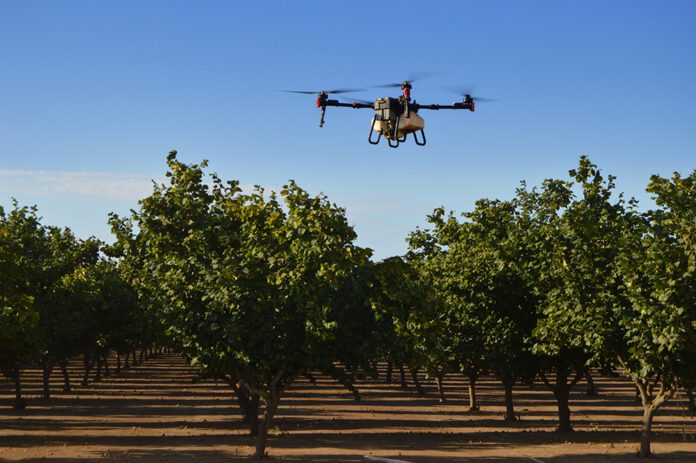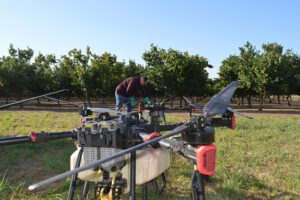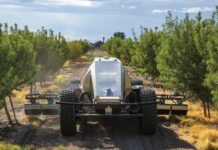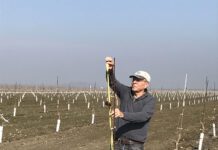
Hazelnut grower Ken Baker was looking to treat for filbert worm as the spray season was winding to a close in mid-August, but he was hesitant to run the air blast sprayer through the orchard.
“The limbs are heavy this time of year, and I didn’t want to take the tractor and air blast sprayer through the orchard and knock them off,” Baker said.
Baker looked at helicopters and airplanes, but ultimately decided to go with Pratum Co-op’s drone application program.
“I think this is great technology,” Baker said. “I use the air blast as long as I can, but this deep in the growing season, this just makes sense.”
Baker is one of many Oregon hazelnut growers turning to Pratum Co-op’s drone program these days, a program that has grown rapidly over the last year and a half. The company started with one drone and one pilot in February 2023. Today, it has four drones and a crew of five operating the systems.

“When we first set it up, we didn’t know how much work we were going to get,” said Chris Kaiser, manager of the Ag Services Department at Pratum Co-op, a Salem-based full-service agricultural retailer. “Now we have more work than we know what to do with.”
Growers utilize drones to apply preventive sprays against eastern filbert blight (EFB) in the spring and for hazelnut filbert worm in the summer, Kaiser said. And growers are finding good success.
The technology offers several advantages over ground applications, Kaiser said, including an ability to apply materials when wet soils prevent applications with ground equipment.
“For growers, in the March and April timeframe, it can be nearly impossible a lot of times to go out with a ground rig because it is still pretty muddy,” Kaiser said. “And a lot of times, airplane companies get overbooked, so the growers don’t get the applications on like they should be doing.”
Also, Kaiser said, growers can achieve better coverage when applying sprays by drone than applying by airplane, in part because drones are able to reach areas airplanes can’t. And, he said, drone applications are faster than by ground and require less labor, an issue that is top-of-mind for many growers as Oregon’s agricultural overtime rules take effect.

EFB Sprays
One development that has helped spur interest in the use of drones in hazelnuts over the past year is the fact that a new strain of the EFB fungus has entered the Willamette Valley and is infecting hazelnut trees previously thought to be resistant to the disease.
“From last year to this year, we’ve seen quite a few more acres being sprayed because of that,” Kaiser said. “And I think the trend is going to continue to go that way because it is a major concern.”
Filbert worm pressure also appears to be high this year, at least in Baker’s orchard, which is near Canby, Ore.
“The last two years, we’ve been able to just spot spray for it,” Baker said. “This year, we just have to stay after them. I’m hoping this is the final spray.”
Counting all crops, Kaiser said the company treated about 19,000 acres in Oregon with drones last year. That includes several thousand hazelnut acres; about 7,000 acres of blueberries and blackberries; specialty seed crops, such as sugar beets and cabbage; vegetable crops, such as beans and spinach; and clover and grass seed crops.
“We’ve done a decent amount of herbicide applications in clovers and grass fields in the wintertime, and we’ve done some slug bait and vole bait applications as well on grass fields,” he said. “We’ve done a little bit of everything.”
The company’s work in hazelnuts has been solely on co-op member orchards, but Kaiser said the company is willing to branch out if asked. In blueberries and blackberries, he noted, Pratum Co-op has worked with growers outside the co-op for sprays targeting the spotted wing drosophila.

Adding Drones
Pratum’s emergence into the drone application market started with one 7.5-gallon-capacity drone the company purchased in winter 2023. The company added a second 7.5-gallon drone a few months later to meet demand during the summer season, and it added two 13.5-gallon drones this year.
Under most application mixtures, Kaiser said the company can treat between 25 and 30 acres an hour.
“The drones have to be brought back and get their batteries replaced every time they refill, but it only takes a minute and a half to get up in the air again. So, it is a pretty quick turnaround,” he said.
“It is a lot faster with a drone or an airplane than with a ground rig,” Kaiser added.
Oregon State University Plant Pathologist Jay Pscheidt said the university hasn’t tested drone applications in hazelnuts to date, but a team of OSU researchers has tested air application technology against ground rig air blast sprayers. The testing involved collecting buds at the top and bottom of the canopy at bud break and two months later.
“In both cases,” Pscheidt said, “the air blast was able to do a better job with coverage and amount of fungicide on the top and bottom of the canopy.”
Still, Pscheidt said hazelnut growers have had good success with air applications against EFB and the hazelnut filbert worm, and he suspects the benefits of air applications will continue to drive their usage. “Growers know [the sprays are working] when they see good control in the middle of the orchard, but poor in places the aircraft can’t get to, like next to structures and roads,” he said.

He added drones can have an advantage over airplanes in their ability to improve coverage in areas of an orchard where airplanes have trouble reaching. “I suspect a drone will do a good job and maybe can get into those hard-to-reach areas a fixed-wing aircraft can’t,” Pscheidt said.
Baker said he has noticed from experience that airplanes have not been able to treat one corner of his Jefferson orchard that is abutted by oak and fir trees. “This will be able to get into those areas,” Baker said while watching Kaiser’s crew at work. “That is one benefit of this I like.”
Baker also said it was cheaper to go with the drones, given the minimum charge of the airplane application. Generally, Kaiser said applying sprays by drones run less than helicopters but more than by airplane.
Looking ahead, Kaiser said he wouldn’t be surprised if Pratum Co-op adds more drones and more pilots. Particularly in spring months, when demand is high for EFB applications, having more drones on-hand could be beneficial, he said.
“We’re a little bit limited in the springtime in that it doesn’t get daylight until about 7 p.m., and so you’re losing about two hours in the morning compared to the summertime,” Kaiser said. “And so, that definitely has an impact on how many acres we can treat.”
With more drones, he believes the co-op could easily treat over 25,000 acres in fiscal year 2024-25, a 20% increase over its 2023-24 usage.
“The way the business is going, that wouldn’t surprise me one bit,” he said.
From there, the sky’s the limit.















